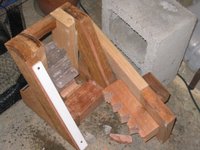 I built a load tester to try to find out how much force the gear teeth could take before shearing off. Unfortunately my results were somewhat discouraging and not entirely conclusive. The first tooth supported 65 pounds (on a 60° ramp, the same angle as the clock's ramp) but failed with 220 pounds. The second tooth failed with 150 pounds. The third tooth supported 150 pounds but failed with 220 pounds.
I built a load tester to try to find out how much force the gear teeth could take before shearing off. Unfortunately my results were somewhat discouraging and not entirely conclusive. The first tooth supported 65 pounds (on a 60° ramp, the same angle as the clock's ramp) but failed with 220 pounds. The second tooth failed with 150 pounds. The third tooth supported 150 pounds but failed with 220 pounds.
In ideal circumstances, such as a complete lack of friction throughout the gear train, I estimate that the sled will have to weigh 103 pounds. We may be able to do some things to reduce the required weight a bit, but I'm not certain how much. To be safe, I would prefer to be able to count on the teeth supporting a sled of 150 pounds.
The test was non-ideal for several reasons. The gear was only 9 cm thick whereas the gears experiencing the most force in the clock are designed to be 10 cm thick. The gear was not cut very well, mostly because my lack of a drill press prevented me from using a very precise method of aligning the gear blank on the gear tooth cutter when I flipped it over to the second side. The quality of the ice was marginal. It had quite a few air bubbles, unlike the arctic diamond we will be working with at the competition. The load tester was hastily designed and constructed, so the gear wasn't seated perfectly against the racks, and I believe the load was uneven across the length of each tooth.
 Even taking into account the imperfections of the test, the results were a bit troubling, so Lars and I have decided to increase the thickness of the first two gears in the gear train from 10 cm to 15 cm. The test also points out that we absolutely must make our best effort to cut the gear teeth precisely and align all of the axles correctly.
Even taking into account the imperfections of the test, the results were a bit troubling, so Lars and I have decided to increase the thickness of the first two gears in the gear train from 10 cm to 15 cm. The test also points out that we absolutely must make our best effort to cut the gear teeth precisely and align all of the axles correctly.






No comments:
Post a Comment